A Framework for Industry 4.0 Readiness and Maturity of Smart Manufacturing Enterprises: A Case Study
Abstract
1. Introduction
2. Existing Maturity Models and Frameworks
2.1. Industry 4.0: Maturity Models
2.2. Industry 4.0: Standards and Frameworks
2.3. Technology Forecasting Applications
- Guidance of resource allocation
- Identification of market opportunities or threats
- Guidance of staff, facilities, or capital planning
- Development of strategies or policies
- Assistance with R&D management
- Evaluation of new products
- Maximize gain or minimize loss due to internal or external elements of the organization
3. Research Methodology
3.1. Proposed Maturity Model
3.1.1. Factory 4.0
3.1.2. Logistics 4.0
- Change in the production paradigm to mass customization in logistics [82];
- Replacement of existing logistics operations with the new digital technologies, e.g., CPS, IoT, etc.;
- Consideration of human factors and product customization toward changing environments, e.g., employees, customers, and stakeholders.
3.1.3. Operator 4.0
3.1.4. Management 4.0
3.2. Assessment Evaluation
3.3. Proposed Framework
3.3.1. Framework Layers
3.3.2. Life Cycle Value Stream
- 8.
- Flow 1: Initial requirements to obtain a new product for the organization.
- 9.
- Flow 2: The theoretical strategy and capability development of the new product for the organization.
- 10.
- Flow 3: Continuation of the existing business in parallel to the new product.
- 11.
- Flow 4: The development of product processes in manufacturing.
- 12.
- Flow5: Providing goods and services after obtaining a new product.
- 13.
- Continuous Improvement: Monitoring and continuously improving the product.
3.3.3. Hierarchy Levels
3.4. Survey Design
3.5. Technology Forecasting
4. Case Study
- RMSE < ~0.1
- 0.1 < RMSE < ~0.2
- 0.2 < RMSE
5. Discussion
- Develop concepts for pilot projects and conduct a cost–benefit analysis based on existing use cases from research or industry associations;
- Develop pilot applications of artificial intelligence for processes and machines;
- Continually improve data collection and review the corresponding system of indicators and targets;
- Quantify the benefits of data collection;
- Examine what information can be obtained from the data already collected. Can patterns be identified? Do they provide the basis for simulations? Do they yield a consistent digital model of the value added and which gaps need to be closed?
- Information sharing is still limited to only a few departments. An analysis should be run to determine where bottlenecks exist between systems and where potential can be leveraged by integrating information sharing into the system.
- Production should be analyzed to determine where it makes sense to introduce autonomous control into processes. Partnering with other companies or sharing knowledge with research institutions can help hasten progress.
- The areas in which IT security solutions are needed should be defined.
- A clear scheduling and maintenance strategy should be adopted.
- To achieve greater Industry 4.0 readiness, it is important to gradually expand the add-on functionalities of products.
- Identify the areas in which potential could be leveraged by offering augmented reality.
- Industry 4.0 is already being implemented in departmental pilot initiatives, but the strategic relevance is lacking. A viable Industry 4.0 strategy must be developed.
- Cost–benefit analysis of Industry 4.0 investment should be periodically included in top management meetings.
- Include operators in communication and socio-technology meetings that involve the policies of the organization, processes, and structures.
6. Conclusions
- Exploring the adoption of I4.0 based on the literature.
- Proposing an MM and F/W method to provide insight for smart manufacturing enterprises into the current situation regarding I4.0 adoption.
- Develop a survey to collect data from the real-world company.
- Adopt a TF that helps with the explicit identification of gap areas and predicts the growth in I4.0 knowledge, awareness, and adoption.
- Provide insight into the current situation by exploring solutions for I4.0 integration and obtain the maximum potential of I4.0.
- The application of the proposed MM and F/W to various companies in other industrial sectors.
- The application of the proposed MM and F/W to various companies in the same country or same region to assess I4.0 maturity level of the country or region.
- A combination of more than one MM to provide more accurate prediction compared with the use of an individual model.
- Other technology forecasting methods can be applied.
Author Contributions
Funding
Institutional Review Board Statement
Informed Consent Statement
Data Availability Statement
Conflicts of Interest
References
- Akay, M. Endüstri 4.0 ile Akıllı Tarıma Geçiş. General Directorate of Agricultural Research and Policies. 2018. Available online: https://www.researchgate.net/profile/Melek-Akay-2/publication/326550785_ENDUSTRI_40_ILE_AKILLI_TARIMA_GECIS/links/5d2d95ff92851cf440874342/ENDUeSTRI-40-ILE-AKILLI-TARIMA-GECIS.pdf (accessed on 10 January 2021).
- UNIDO. Industry 4.0—The opportunities behind the Challenge. In Proceedings of the 17th UNIDO General Conference, Vienna, Austria, 1 December 2017. [Google Scholar]
- Stiftung, B. Sozialer Zusammenhalt in Deutschland. Radar gesellschaftlicher Zusammenhalt. 2017. Available online: https://www.google.com/url?sa=t&rct=j&q=&esrc=s&source=web&cd=&ved=2ahUKEwjo06K00IrxAhXMh1wKHYQyDpIQFjACegQIBBAE&url=http%3A%2F%2Fu.epd.de%2Fwzs&usg=AOvVaw0pkNTtfM4tviDoO1wFF8Ov (accessed on 21 December 2020).
- Jovanovski, B.; Seykova, D.; Boshnyaku, A.; Fischer, C.J.I. The impact of Industry 4.0 on the competitiveness of SMEs. Int. Sci. J. 2019, 4, 250–255. [Google Scholar]
- Sanchez, D.O.M. Sustainable Development Challenges and Risks of Industry 4.0: A literature review. In Proceedings of the 2019 Global IoT Summit (GIoTS), Aarhus, Denmark, 17–21 June 2019; pp. 1–6. [Google Scholar]
- Ramirez-Peña, M.; Sotano, A.J.S.; Pérez-Fernandez, V.; Abad, F.J.; Batista, M. Achieving a sustainable shipbuilding supply chain under I4. 0 perspective. J. Clean. Prod. 2020, 244, 118789. [Google Scholar] [CrossRef]
- Dastbaz, M. Industry 4.0 (I4.0): The Hype, the Reality, and the Challenges Ahead. In Industry 4.0 and Engineering for a Sustainable Future; Dastbaz, M., Cochrane, P., Eds.; Springer International Publishing: Cham, Switzerland, 2019; pp. 1–11. [Google Scholar]
- Alcácer, V.; Cruz-Machado, V. Scanning the Industry 4.0: A Literature Review on Technologies for Manufacturing Systems. Eng. Sci. Technol. Int. J. 2019, 22, 899–919. [Google Scholar] [CrossRef]
- Weston, R.H.; Cui, Z. Next Generation Manufacturing Systems. In Proceedings of the Global Design to Gain a Competitive Edge, London, UK, 1 January 2008; pp. 701–710. [Google Scholar]
- Erboz, G. How to define industry 4.0: Main pillars of industry 4.0. Managerial Trends in the Development of Enterprises in Globalization Era. 2017, pp. 761–767. Available online: https://www.researchgate.net/profile/Gizem-Erboz-2/publication/326557388_How_To_Define_Industry_40_Main_Pillars_Of_Industry_40/links/5fc553374585152e9be7f201/How-To-Define-Industry-40-Main-Pillars-Of-Industry-40.pdf (accessed on 13 March 2021).
- Saad, S.M.; Bahadori, R.; Jafarnejad, H. The smart SME technology readiness assessment methodology in the context of industry 4.0. J. Manuf. Technol. Manag. 2021. [Google Scholar] [CrossRef]
- Moeuf, A.; Pellerin, R.; Lamouri, S.; Tamayo-Giraldo, S.; Barbaray, R. The industrial management of SMEs in the era of Industry 4.0. Int. J. Prod. Res. 2018, 56, 1118–1136. [Google Scholar] [CrossRef]
- Hübner, M.; Liebrecht, C.; Malessa, N.; Kuhnle, A.; Nyhuis, P.; Lanza, G. A process model for implementing Industry 4.0-Introduction of a process model for the individual implementation of Industry 4.0 methods. Wt Werkstattstech 2017, 107, 266–272. [Google Scholar]
- Schumacher, A.; Erol, S.; Sihn, W. A maturity model for assessing Industry 4.0 readiness and maturity of manufacturing enterprises. Procedia Cirp 2016, 52, 161–166. [Google Scholar] [CrossRef]
- Matt, D.T.; Rauch, E.; Riedl, M. Knowledge transfer and introduction of industry 4.0 in SMEs: A five-step methodology to introduce industry 4.0. In Analyzing the Impacts of Industry 4.0 in Modern Business Environments; IGI Global: Hershey, PA, USA, 2018; pp. 256–282. [Google Scholar]
- Rauch, E.; Unterhofer, M.; Rojas, R.A.; Gualtieri, L.; Woschank, M.; Matt, D.T. A maturity Level-Based assessment tool to enhance the implementation of industry 4.0 in small and Medium-Sized enterprises. Sustainability 2020, 12, 3559. [Google Scholar] [CrossRef]
- Chonsawat, N.; Sopadang, A. Smart SMEs 4.0 maturity model to evaluate the readiness of SMEs implementing industry 4.0. CMUJ. Nat. Sci. 2021, 20, e2021027. [Google Scholar]
- UNIDO. What Can Policymakers Learn From Germany’s Industrie 4.0 Development Strategy? In Inclusive and Sustainable Industrial Development Working Paper Series; UNIDO: Vienna, Austria, 2018; Available online: https://www.researchgate.net/profile/Fernando-Santiago-5/publication/326905127_What_can_policymakers_learn_from_Germany’s_Industrie_40_development_strategy/links/5b73d8bd92851ca65061e857/What-can-policymakers-learn-from-Germanys-Industrie-40-development-strategy.pdf (accessed on 15 February 2021).
- Horick, C. Industry 4.0 Production Networks: Cyber-Physical System-based Smart Factories, Real-Time Big Data Analytics, and Sustainable Product Lifecycle Management. J. Self-Gov. Manag. Econ. 2020, 8, 107–113. [Google Scholar]
- Peters, E.; Kliestik, T.; Musa, H.; Durana, P. Product decision-making information systems, real-time big data analytics, and deep learning-enabled smart process planning in sustainable industry 4.0. J. Self-Gov. Manag. Econ. 2020, 8, 16–22. [Google Scholar]
- Coatney, K.; Poliak, M. Cognitive Decision-Making Algorithms, Internet of Things Smart Devices, and Sustainable Organizational Performance in Industry 4.0-based Manufacturing Systems. J. Self-Gov. Manag. Econ. 2020, 8, 9–18. [Google Scholar]
- Davidson, R. Cyber-Physical Production Networks, Artificial Intelligence-based Decision-Making Algorithms, and Big Data-driven Innovation in Industry 4.0-based Manufacturing Systems. Econ. Manag. Financ. Mark. 2020, 15, 16–22. [Google Scholar]
- Duft, G.; Durana, P. Artificial Intelligence-based Decision-Making Algorithms, Automated Production Systems, and Big Data-driven Innovation in Sustainable Industry 4.0. Econ. Manag. Financ. Mark. 2020, 15, 9–18. [Google Scholar]
- Hyers, D. Big Data-driven Decision-Making Processes, Industry 4.0 Wireless Networks, and Digitized Mass Production in Cyber-Physical System-based Smart Factories. Econ. Manag. Financ. Mark. 2020, 15, 19–28. [Google Scholar]
- Sartal, A.; Bellas, R.; Mejías, A.M.; García-Collado, A. The sustainable manufacturing concept, evolution and opportunities within Industry 4.0: A literature review. Adv. Mech. Eng. 2020, 12. [Google Scholar] [CrossRef]
- Simpson, J.; Weiner, E. The Oxford English Dictionary; Oxford University Press: Oxford, UK, 1989; Volume 17, pp. 655–656. [Google Scholar]
- Kohlegger, M.; Maier, R.; Thalmann, S. Understanding Maturity Models. Results of a Structured Content Analysis. 2009. Available online: https://www.researchgate.net/profile/Stefan-Thalmann/publication/290265437_Understanding_maturity_models_results_of_a_structured_content_analysis/links/5867d72f08ae8fce4915c649/Understanding-maturity-models-results-of-a-structured-content-analysis.pdf (accessed on 28 November 2020).
- Gökalp, E.; Şener, U.; Eren, P.E. Development of An Assessment Model For Industry 4.0: Industry 4.0-MM. In Proceedings of the International Conference on Software Process Improvement and Capability Determination, Tessaloniki, Greece, 9–10 October 2018; pp. 128–142. [Google Scholar]
- Akdil, K.Y.; Ustundag, A.; Cevikcan, E. Maturity and readiness model for industry 4.0 strategy. In Industry 4.0: Managing The Digital Transformation; Springer: Manhattan, NY, USA, 2018; pp. 61–94. [Google Scholar]
- Fallaha, M.; Cinar, Z.M.; Korhan, O.; Zeeshan, Q. Operator 4.0 and Cognitive Ergonomics. In Industrial Engineering in the Digital Disruption Era. GJCIE 2019; Calisir, F., Korhan, O., Eds.; Lecture Notes in Management and Industrial Engineering; Springer: Cham, Switzerland, 2020. [Google Scholar]
- Temur, G.T.; Bolat, H.B.; Gözlü, S. Evaluation of Industry 4.0 Readiness Level: Cases from Turkey. In Proceedings of the International Symposium for Production Research, Vienna, Austria, 13–15 September 2017; pp. 412–425. [Google Scholar]
- Bauer, W.; Horváth, P. Industrie 4.0-Volkswirtschaftliches Potenzial für Deutschland. Controlling 2015, 27, 515–517. [Google Scholar] [CrossRef]
- Rockwell Automation. The Connected Enterprise Maturity Model. Int. Comm. Illum. 2014, 27, 515–517. [Google Scholar] [CrossRef]
- IMPULS. Industrie 4.0 Readiness. VDMA’s IMPULS-Stift. 2015, pp. 1–76. Available online: http://industrie40.vdma.org/documents/4214230/5356229/Industrie%204.0%20Readiness%20Study%20English.pdf/f6de92c1-74ed-4790-b6a4-74b30b1e83f0 (accessed on 15 February 2021).
- Hankel, M.; Rexroth, B. The Reference Architectural Model Industrie 4.0 (RAMI 4.0). ZVEIApril. 2015, p. 410. Available online: http://przemysl-40.pl/wp-content/uploads/2010-The-Reference-Architectural-Model-Industrie-40.pdf (accessed on 15 February 2020).
- Back, A.; Berghaus, S.; Kaltenrieder, B.J.I.f.W. Universität St. Gallen. Digital Maturity & Transformation Studie. Digit. Matur. Transform. Stud. 2015, 1, 1–75. [Google Scholar]
- Jodlbauer, H.; Schagerl, M. Reifegradmodell industrie 4.0-ein vorgehensmodell zur identifikation von industrie 4.0 potentialen. Informatik. 2016. Available online: https://www.semanticscholar.org/paper/Reifegradmodell-Industrie-4.0-Ein-Vorgehensmodell-Jodlbauer-Schagerl/8d7fdd5f24f971b8a23511ea1b9a0ccd9774b7ce (accessed on 26 May 2020).
- Lanza, G.; Nyhuis, P.; Ansari, S.; Kuprat, T.; Liebrecht, C. Empowerment and implementation strategies for Industry 4.0. ZWF Z. Für Wirtsch. Fabr. 2016, 111, 76–79. [Google Scholar]
- Menon, K.; Kärkkäinen, H.; Lasrado, L.A. Towards a Maturity Modeling Approach for the Implementation of Industrial Internet. In Proceedings of the Pacis, Chiayi, Taiwan, China, 27 June 2016; p. 38. [Google Scholar]
- Qin, J.; Liu, Y.; Grosvenor, R. A Categorical Framework of Manufacturing for Industry 4.0 and Beyond. Procedia CIRP 2016, 52, 173–178. [Google Scholar] [CrossRef]
- PricewaterhouseCoopers (PWC). Industry 4.0 Building the Digital Enterprise. 2016. Available online: https://doi.org/www.pwc.com/gx/en/industries/industrial-manufacturing/publications/assets/pwc-building-digital-enterprise.pdf (accessed on 22 April 2020).
- Leyh, C.; Bley, K.; Schäffer, T.; Forstenhäusler, S. SIMMI 4.0-a maturity model for classifying the enterprise-wide it and software landscape focusing on Industry 4.0. In Proceedings of the 2016 Federated Conference on Computer Science and Information Systems (FedCSIS), Gdańsk, Poland, 11–14 September 2016; pp. 1297–1302. [Google Scholar]
- Schuh, G.; Anderl, R.; Gausemeier, J.; Ten Hompel, M.; Wahlster, W. Industrie 4.0 Maturity Index: Die Digitale Transformation von Unternehmen Gestalten; Herbert Utz Verlag: Munich, Germany, 2017. [Google Scholar]
- De Carolis, A.; Macchi, M.; Negri, E.; Terzi, S. A maturity model for assessing the digital readiness of manufacturing companies. In Proceedings of the IFIP International Conference on Advances in Production Management Systems, Novi Sad, Serbia, 30 August–3 September 2018; pp. 13–20. [Google Scholar]
- The University of Warwick (WMG). An Industry 4 Readiness Assessment Tool; WMG-University Warwick: Coventry, UK, 2017. [Google Scholar]
- Wagire, A.A.; Joshi, R.; Rathore, A.P.S.; Jain, R. Development of maturity model for assessing the implementation of Industry 4.0: Learning from theory and practice. Prod. Plan. Control 2020, 32, 1–20. [Google Scholar] [CrossRef]
- Lin, S.-W.; Miller, B.; Durand, J.; Bleakley, G.; Chigani, A.; Martin, R.; Murphy, B.; Crawford, M. The Industrial Internet of Things Volume G1: Reference Architecture. Industrial Internet Consortium. 2017. Available online: https://www.iiconsortium.org/pdf/SHI-WAN%20LIN_IIRA-v1%208-release-20170125.pdf (accessed on 2 July 2020).
- Mettler, T. A Design Science Research Perspective on Maturity Models in Information Systems. 2009. Available online: https://www.alexandria.unisg.ch/214531/ (accessed on 19 July 2020).
- DIN Deutsches Institut für Normung. DIN Standards. Available online: https://www.din.de/en/innovation-and-research/industry-4-0 (accessed on 19 July 2020).
- Rojko, A. Industry 4.0 Concept: Background and Overview. Int. J. Interact. Mob. Technol. (Ijim) 2017, 11. [Google Scholar] [CrossRef]
- da Silva Correia, M.A. Industrie 4.0 Framework, Challenges and Perspectives; Hochschule RheinMain: Munich, Germany, 2014. [Google Scholar]
- Adolphs, P.; Epple, U. Statusreport: Referenzarchitekturmodell Industrie 4.0 (RAMI4. 0). Verb. Der Elektrotechnik. 2015. Available online: https://www.zvei.org/fileadmin/user_upload/Presse_und_Medien/Publikationen/2016/januar/GMA_Status_Report__Reference_Archtitecture_Model_Industrie_4.0__RAMI_4.0_/GMA-Status-Report-RAMI-40-July-2015.pdf (accessed on 5 August 2020).
- Zezulka, F.; Marcon, P.; Vesely, I.; Sajdl, O. Industry 4.0–An Introduction in the phenomenon. IFAC-Pap. 2016, 49, 8–12. [Google Scholar] [CrossRef]
- CEN-CENELEC-ETSI Smart Grid Coordination Group. CEN-CENELEC-ETSI Smart Grid Coordination Group Smart Grid Reference Architecture. CEN-CENELEC Manag. Cent. 2012. Available online: https://ec.europa.eu/energy/sites/ener/files/documents/xpert_group1_reference_architecture.pdf (accessed on 12 March 2021).
- Fraile, F.; Sanchis, R.; Poler, R.; Ortiz, A. Reference Models for Digital Manufacturing Platforms. Appl.Sci. 2019, 9, 4433. [Google Scholar] [CrossRef]
- Kosanke, K. The European approach for an open system architecture for CIM (CIM-OSA)—ESPRIT Project 5288 AMICE. Comput. Control Eng. J. 1991, 2, 103–108. [Google Scholar] [CrossRef]
- Liu, F.; Tong, J.; Mao, J.; Bohn, R.; Messina, J.; Badger, L.; Leaf, D.J.N.s.p. NIST Cloud Computing Reference Architecture; Special Publication (NIST SP): Gaithersburg, MD, USA, 2011; Volume 500, p. 292. [Google Scholar]
- Wei, S.; Hu, J.; Cheng, Y.; Ma, Y.; Yu, Y. The Essential Elements Of Intelligent Manufacturing System Architecture. In Proceedings of the 2017 13th IEEE Conference on Automation Science and Engineering (CASE), Xi’an, China, 20–23 August 2017; pp. 1006–1011. [Google Scholar]
- American National Institute of Standards and Technology. Software Requirements Specification to Distribute Manufacturing Data; American National Institute of Standards and Technology: Gaithersburg, MD, USA, 2017.
- IBM. Announcing the IoT Industrie 4.0 Reference Architecture. Available online: https://www.ibm.com/cloud/blog/announcements/iot-industrie-40-reference-architecture (accessed on 31 March 2020).
- Porter, A.L. Tech forecasting an empirical perspective. Technol. Forecasting. Soc. Chang. 1999, 62, 19–28. [Google Scholar] [CrossRef]
- Meade, P.T.; Rabelo, L. The technology adoption life cycle attractor: Understanding the dynamics of high-tech markets. Technol. Forecasting. Soc. Chang. 2004, 71, 667–684. [Google Scholar] [CrossRef]
- Carrillo, M.; González, J.M. A new approach to modelling sigmoidal curves. Technol. Forecasting. Soc. Chang. 2002, 69, 233–241. [Google Scholar] [CrossRef]
- Frank, M.J.; Seeberger, L.C.; O’reilly, R.C. By carrot or by stick: Cognitive reinforcement learning in parkinsonism. Science 2004, 306, 1940–1943. [Google Scholar] [CrossRef] [PubMed]
- Vanston, L. Forecasts for internet/online access. In Forecasting the Internet; Springer: Manhattan, NY, USA, 2002; pp. 45–58. [Google Scholar]
- Chen, S. Strategic Management of E-Business. 2005. Available online: https://d1wqtxts1xzle7.cloudfront.net/31426495/strategic_eBusiness1.pdf?1371783176=&response-content-disposition=inline%3B+filename%3DStrategic_E_Business.pdf&Expires=1623252754&Signature=ZtTxeI5y9bV0rksdjoH~cuuiWJ3dRw2dF-WILKCYBX79NUjSxGJKzKqO9nF0kLX5LlgB7xZTt7I8I4CCGy1uAD8xWuOgTLhsXeWYllFHJwz~-EmnzVXQ4VWTcf7ffwf4TwM9~20lvUgKTBHWYgp1kEfEFisHqmAetqSeGhJva8c4zahD5AV~MPRH8vRzncyilVocqygOf3R5FPZdHZWtPSyu5mMRBMqkJJnpqYItEKQsk9x-AXNYWexdKXZzIT596KDybthuBghJco~StvPWssarx2PrDLmUMU82GfoqmR9HvE-c7Ia9d6T9N~qiMab-Gb9IeBs2tuCEFItFYvVz~w__&Key-Pair-Id=APKAJLOHF5GGSLRBV4ZA (accessed on 30 December 2020).
- Saunders, M.; Lewis, P.; Thornhill, A. Research Methods for Business Students (no. Book, Whole); Pearson Educ. Ltd.: HarlowEssex, UK, 2016. [Google Scholar]
- Shoemaker, P.J.; McCombs, M.E. Survey research. Mass Commun. Res. Theory 2003, 80, 231–251. [Google Scholar]
- Neuman, L.W. Social Research Methods, 6/E.; Pearson Education India: New Delhi, India, 2007. [Google Scholar]
- Taylor-Powell, E.; Hermann, C. Collecting Evaluation Data: Surveys; University of Wisconsin: Madison, WI, USA, 2000. [Google Scholar]
- Koska, A.; Goksu, N.; Erdem, M.B.; Fettahlioglu, H.S. Measuring the Maturity of a Factory for Industry 4.0. Int. J. Acad. Res. Bus. Soc. Sci. 2017, 7. [Google Scholar] [CrossRef]
- A Categorical Framework of Manufacturing for Industry 4.0 and beyond. ScienceDirect. 2016. Available online: https://www.sciencedirect.com/science/article/pii/S221282711630854X (accessed on 5 June 2021).
- Unterhofer, M. Assessment Model for Industrial Companies to Define the Maturity Level of Industry 4.0 Implementation; Free University of Bozen-Bolzano: Bolzano, Italy, 2018. [Google Scholar]
- Barbato, M.; Ceselli, A.; Premoli, M. Evaluating Automated Storage and Retrieval System Policies with Simulation and Optimization. In Advances in Optimization and Decision Science for Society, Services and Enterprises; Springer: Manhattan, NY, USA, 2019; pp. 127–137. [Google Scholar]
- Weber, C.; Königsberger, J.; Kassner, L.; Mitschang, B. M2DDM—A Maturity Model for Data-Driven Manufacturing. Procedia CIRP 2017, 63, 173–178. [Google Scholar] [CrossRef]
- Anderl, R.; Anokhin, O.; Arndt, A. Efficient Factory 4.0 Darmstadt—Industrie 4.0 Implementation for Midsize Industry. In The Internet of Things: Industrie 4.0 Unleashed; Sendler, U., Ed.; Springer: Berlin/Heidelberg, Germany, 2018; pp. 117–131. [Google Scholar]
- Paksoy, T.; Kochan, C.G.; Ali, S.S. Logistics 4.0: Digital Transformation of Supply Chain Management; CRC Press: Boca Raton, FL, USA, 2020. [Google Scholar]
- Romero, D.; Stahre, J.; Taisch, M. The Operator 4.0: Towards socially sustainable factories of the future. Comput. Ind. Eng. 2020, 139, 106128. [Google Scholar] [CrossRef]
- Naqbi, M.Y.K.K.A. Management 4.0 The impact of technologies in management organization. Information Technology innovations in Economics, Finance, Accounting, and Law. 2020, p. 1. Available online: http://www.alexpander.it/12-Management40.pdf (accessed on 5 June 2021).
- Barreto, L.; Amaral, A.; Pereira, T. Industry 4.0 implications in logistics: An overview. Procedia Manuf. 2017, 13, 1245–1252. [Google Scholar] [CrossRef]
- Winkelhaus, S.; Grosse, E.H. Logistics 4.0: A systematic review towards a new logistics system. Int. J. Prod. Res. 2020, 58, 18–43. [Google Scholar] [CrossRef]
- Kuehnle, H. Post mass production paradigm (PMPP) trajectories. J. Manuf. Technol. Manag. 2007, 18, 1022–1037. [Google Scholar] [CrossRef]
- Ruppert, T.; Jaskó, S.; Holczinger, T.; Abonyi, J. Enabling technologies for operator 4.0: A survey. Appl. Sci. 2018, 8, 1650. [Google Scholar] [CrossRef]
- Romero, D.; Stahre, J.; Wuest, T.; Noran, O.; Bernus, P.; Fast-Berglund, Å.; Gorecky, D. Towards an operator 4.0 typology: A human-centric perspective on the fourth industrial revolution technologies. In Proceedings of the International Conference on Computers and Industrial Engineering (CIE46) Proceedings, Tianjin, China, 29–31 October 2016. [Google Scholar]
- Çınar, Z.M.; Abdussalam Nuhu, A.; Zeeshan, Q.; Korhan, O.; Asmael, M.; Safaei, B. Machine learning in predictive maintenance towards sustainable smart manufacturing in industry 4.0. Sustainability 2020, 12, 8211. [Google Scholar] [CrossRef]
- Kans, M.; Ingwald, A. Business model development towards service management 4.0. Procedia CIRP 2016, 47, 489–494. [Google Scholar] [CrossRef]
- Röglinger, M.; Pöppelbuß, J.; Becker, J. Maturity models in business process management. Bus. Process Manag. J. 2012. Available online: https://www.emerald.com/insight/content/doi/10.1108/14637151211225225/full/html (accessed on 5 June 2021). [CrossRef]
- Ayres, R.U.; Kneese, A.V. Production, consumption, and externalities. Am. Econ. Rev. 1969, 59, 282–297. [Google Scholar]
- Lee, H.-j.; Lee, S.; Yoon, B. Technology clustering based on evolutionary patterns: The case of information and communications technologies. Technol. Forecast. Soc. Chang. 2011, 78, 953–967. [Google Scholar] [CrossRef]
- Adamuthe, A.C.; Thampi, G.T. Technology forecasting: A case study of computational technologies. Technol. Forecast. Soc. Chang. 2019, 143, 181–189. [Google Scholar] [CrossRef]
- Ryu, J.; Byeon, S.C. Technology level evaluation methodology based on the technology growth curve. Technol. Forecast. Soc. Chang. 2011, 78, 1049–1059. [Google Scholar] [CrossRef]
- Porter, A.L.; Cunningham, S.W.; Banks, J.; Roper, A.T.; Mason, T.W.; Rossini, F.A. Forecasting and Management of Technology; Wiley Online Library: Hoboken, NJ, USA, 2011. [Google Scholar]
- Winsor, C.P. The Gompertz curve as a growth curve. Proc. Natl. Acad. Sci. USA 1932, 18, 1. [Google Scholar] [CrossRef] [PubMed]
- Oh, H.-S. The Selection of Technological Forecasting Models in Life Analysis. 1988. Available online: https://lib.dr.iastate.edu/rtd/9709/ (accessed on 5 June 2021).
- Kucharavy, D.; De Guio, R. Application of logistic growth curve. Procedia Eng. 2015, 131, 280–290. [Google Scholar] [CrossRef]
- Council, N.R. Persistent Forecasting of Disruptive Technologiesâ—Report 2; National Academies Press: Washington, DC, USA, 2010. [Google Scholar]
- Meade, N.; Islam, T. Forecasting with growth curves: An empirical comparison. Int. J. Forecast. 1995, 11, 199–215. [Google Scholar] [CrossRef]
- EU; BCG; TUSISAD. Digitalization for Productivity and Growth The Future of Productivity and Growth in Manufacturing Industries; Boston Consulting Group: Boston, MA, USA, 2016. [Google Scholar]
- Mittal, S.; Khan, M.A.; Romero, D.; Wuest, T. A critical review of smart manufacturing & Industry 4.0 maturity models: Implications for small and medium-sized enterprises (SMEs). J. Manuf. Syst. 2018, 49, 194–214. [Google Scholar]
- Özlü, F. The Advent of Turkey’s Industry 4.0. Turk. Policy Q. 2017, 16, 29–38. [Google Scholar]
- PricewaterhouseCoopers (PWC). Endüstri 4.0: Çözüm Ortaklığı Platformu Dijital Dönüşümü Anlamak; PWC: London, UK, 2015. [Google Scholar]
- Roland Berger. Industry 4.0—Challenge for the F&B industry in Turkey, Advantage or Competitive Disadvantage; Roland Berger: Munich, Germany, 2017. [Google Scholar]
- Schröder, C. The challenges of industry 4.0 for small and medium-sized enterprises. Friedrich-Ebert-Stiftung. 2016. Available online: https://www.researchgate.net/profile/Christian-Schroeder-24/publication/305789672_The_Challenges_of_Industry_40_for_Small_and_Medium-sized_Enterprises/links/57a1dfe808ae5f8b258a5e69/The-Challenges-of-Industry-40-for-Small-and-Medium-sized-Enterprises.pdf (accessed on 20 January 2021).
- Stark, R.; Kind, S.; Neumeyer, S. Innovations in digital modelling for next generation manufacturing system design. CIRP Ann. 2017, 66, 169–172. [Google Scholar] [CrossRef]
- The Boston Conculting Group (BCG). The_Fourth_Industrial_Revolution_and_Its_Implications; BCG: Boston, MA, USA, 2017. [Google Scholar]
- Weyer, S.; Schmitt, M.; Ohmer, M.; Gorecky, D. Towards Industry 4.0-Standardization as the crucial challenge for highly modular, multi-vendor production systems. Ifac-Pap. 2015, 48, 579–584. [Google Scholar] [CrossRef]
- PricewaterhouseCoopers (PWC). Industry 4.0–Opportunities and Challenges of the Industrial Internet; PricewaterhouseCoopers: London, UK, 2014. [Google Scholar]
- Zhou, K.; Liu, T.; Zhou, L. Industry 4.0: Towards future industrial opportunities and challenges. In Proceedings of the 2015 12th International conference on fuzzy systems and knowledge discovery (FSKD), Zhangjiajie, China, 15–17 August 2015; pp. 2147–2152. [Google Scholar]
- Park, S.H.; Kim, J.; Lee, S.; Lee, D.Y.; Lim, S.; Lee, J.; Kim, S.H. Organic thin-film transistors with sub-10-micrometer channel length with printed polymer/carbon nanotube electrodes. Org. Electron. 2018, 52, 165–171. [Google Scholar] [CrossRef]
- Moeuf, A.; Lamouri, S.; Pellerin, R.; Tamayo-Giraldo, S.; Tobon-Valencia, E.; Eburdy, R. Identification of critical success factors, risks and opportunities of Industry 4.0 in SMEs. Int. J. Prod. Res. 2020, 58, 1384–1400. [Google Scholar] [CrossRef]
- Horváth, D.; Szabó, R.Z. Driving forces and barriers of Industry 4.0: Do multinational and small and medium-sized companies have equal opportunities? Technol. Forecast. Soc. Chang. 2019, 146, 119–132. [Google Scholar] [CrossRef]
- Birkel, H.S.; Müller, J.M. Potentials of Industry 4.0 for Supply Chain Management within the Triple Bottom Line of Sustainability–A Systematic Literature Review. J. Clean. Prod. 2020, 289. Available online: https://www.sciencedirect.com/science/article/pii/S0959652620356584 (accessed on 5 June 2021).
- Müller, J.M.; Veile, J.W.; Voigt, K.-I. Prerequisites and incentives for digital information sharing in Industry 4.0–An international comparison across data types. Comput. Ind. Eng. 2020, 148, 106733. [Google Scholar] [CrossRef]
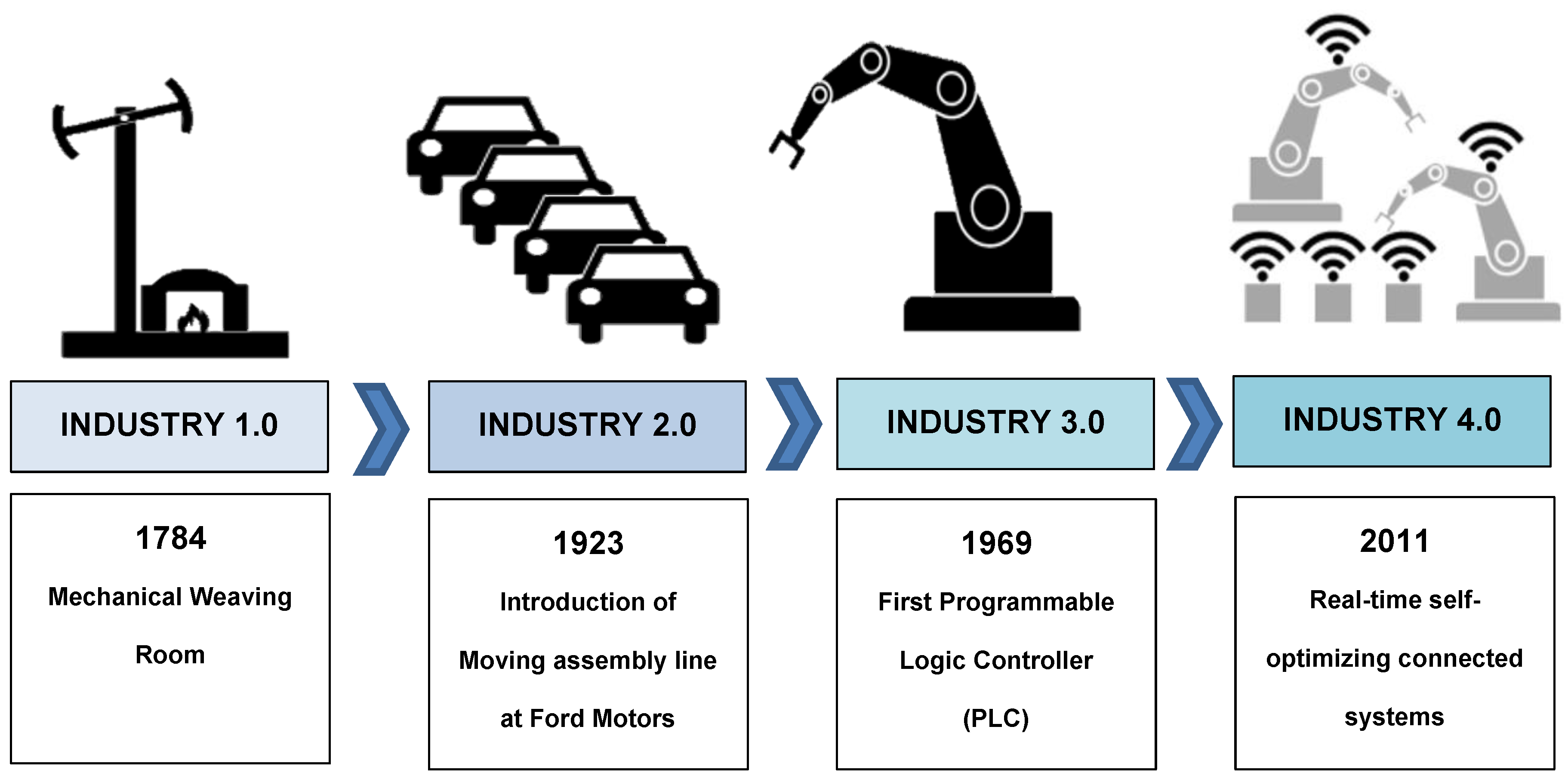

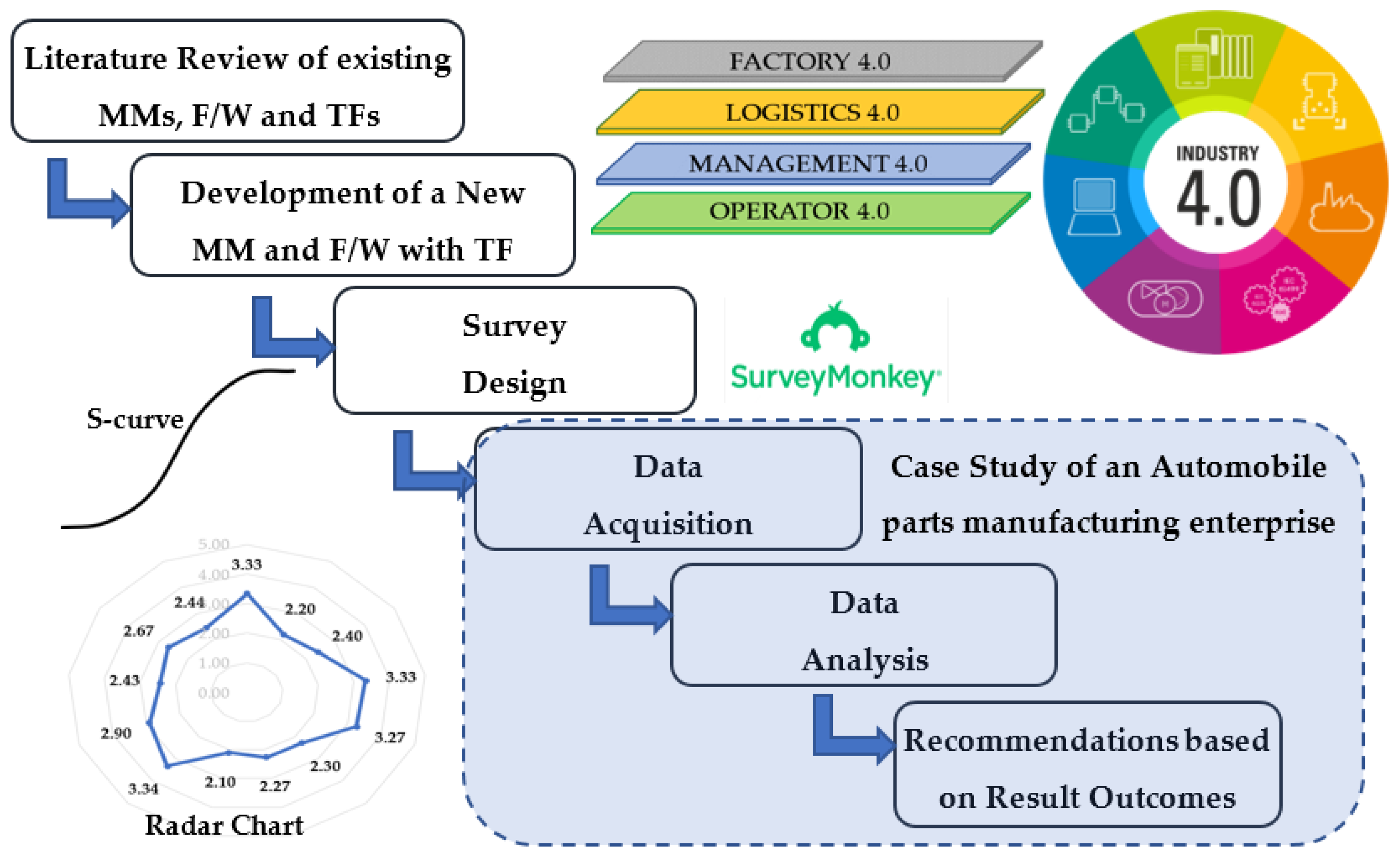



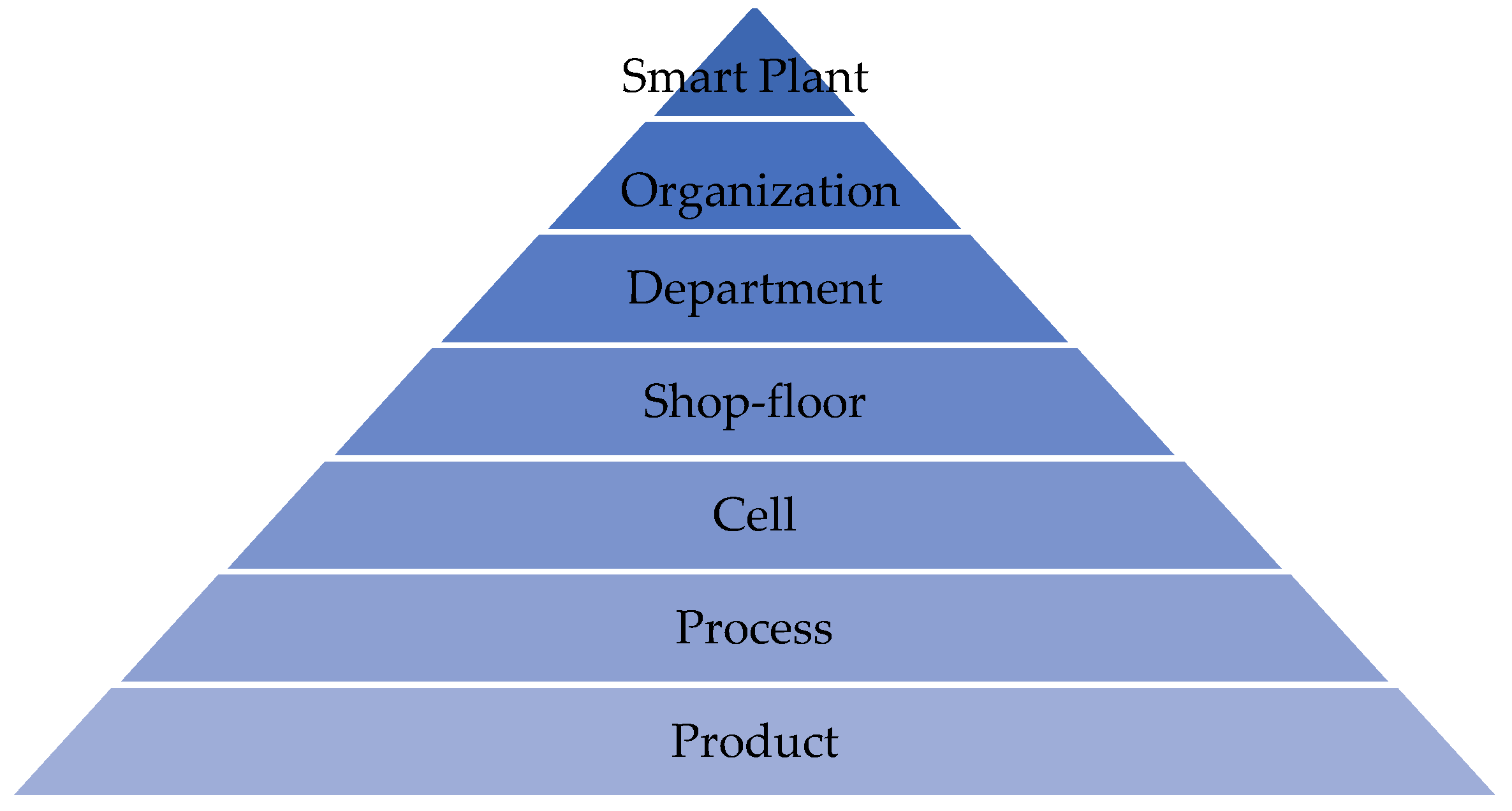
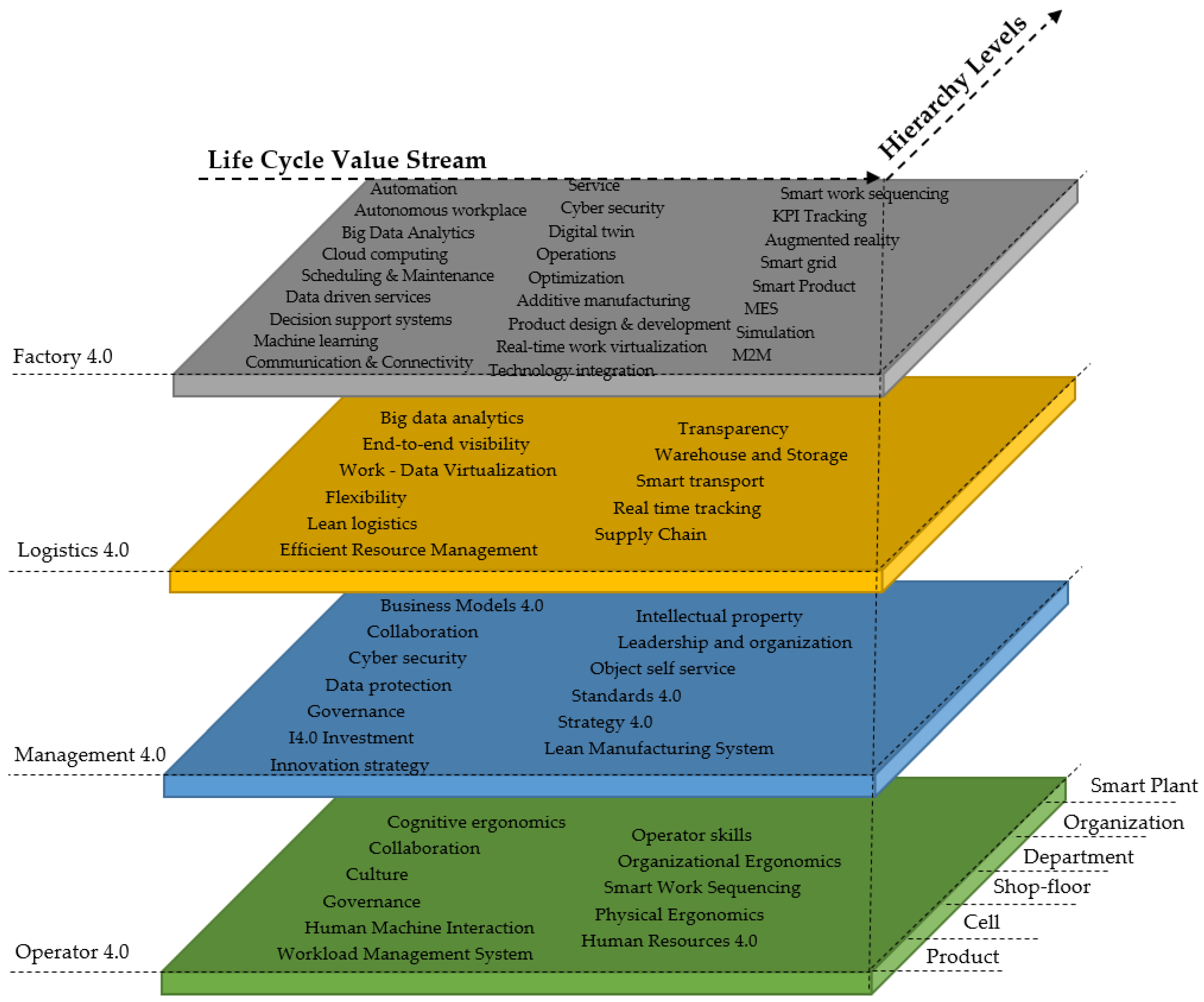
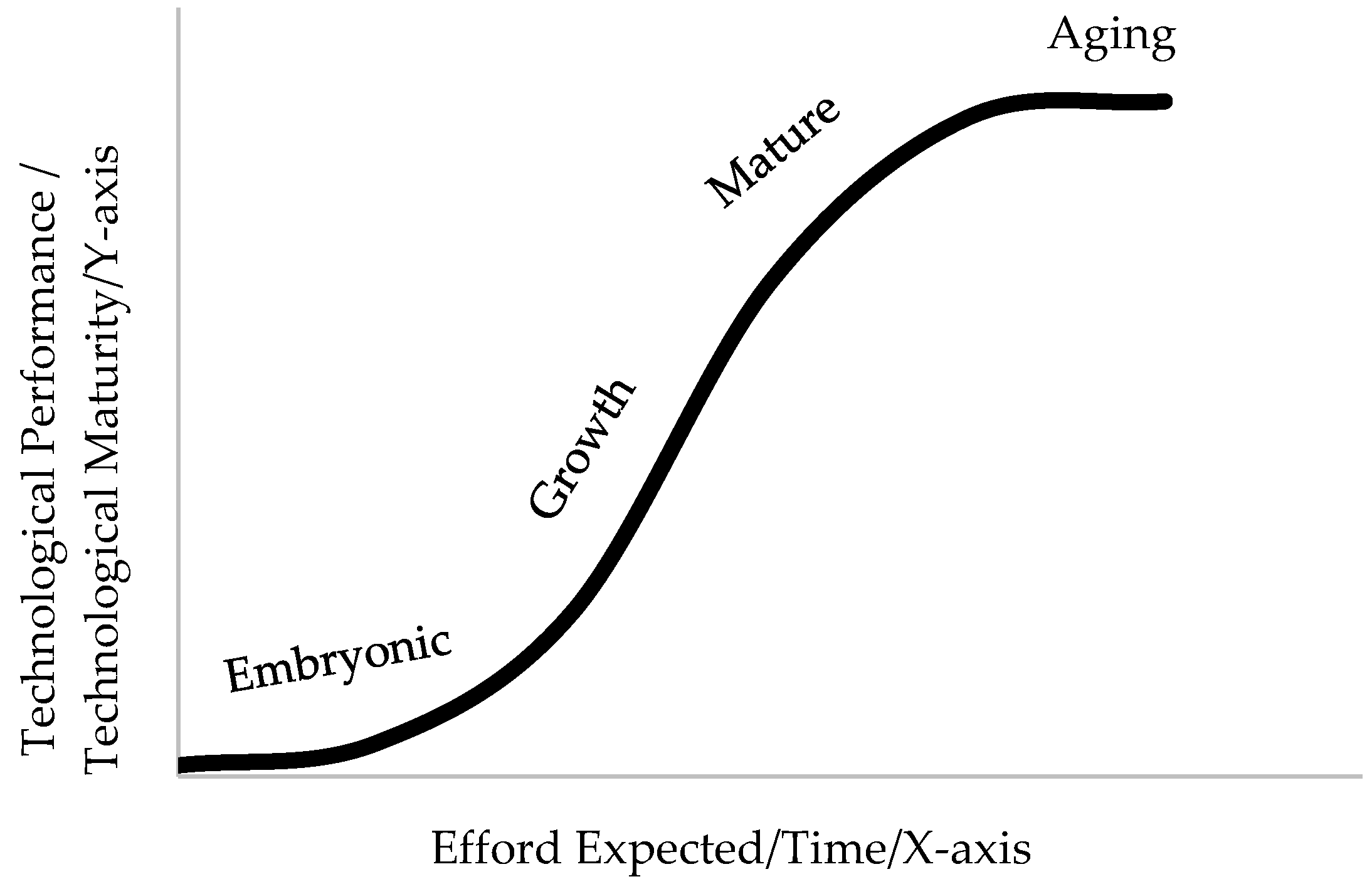

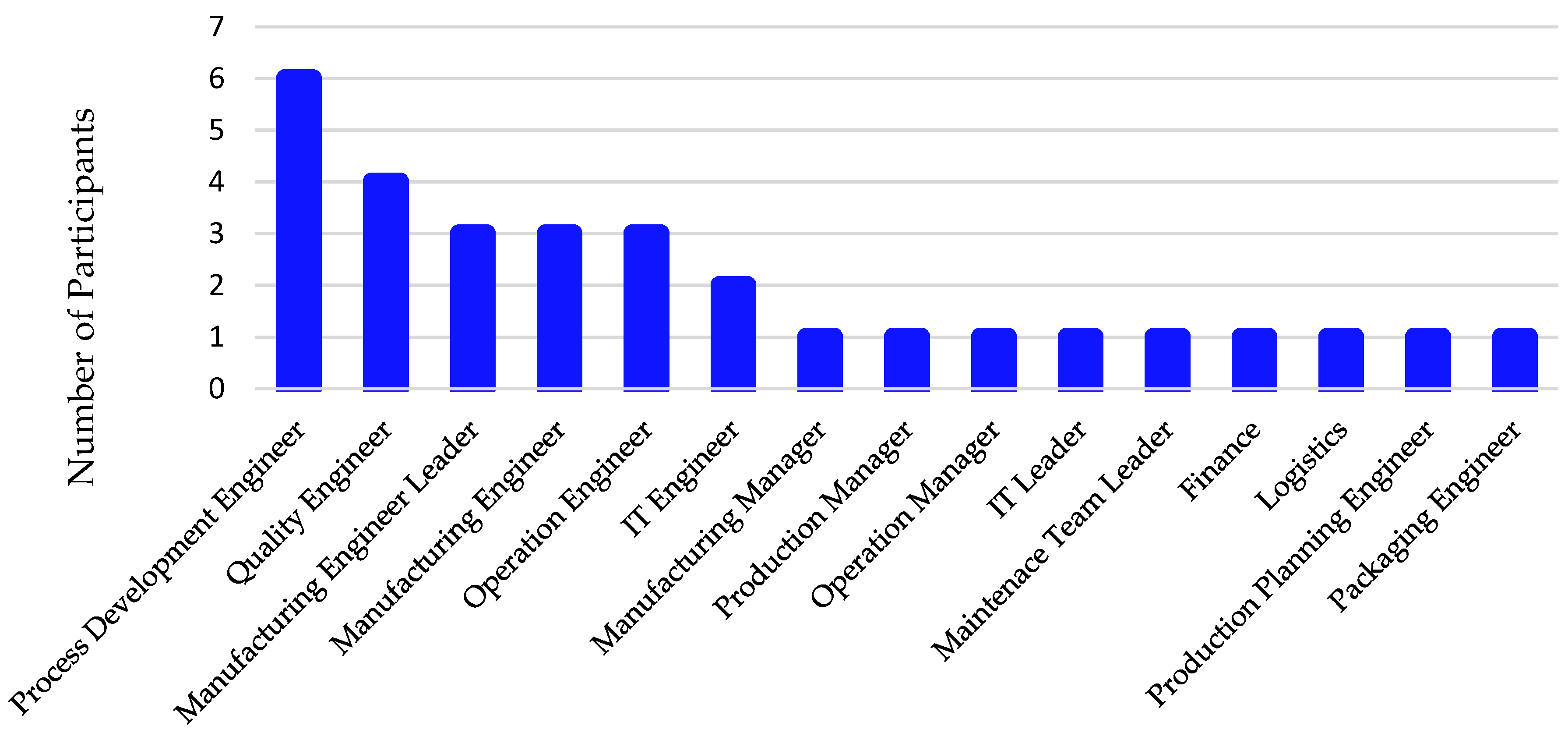
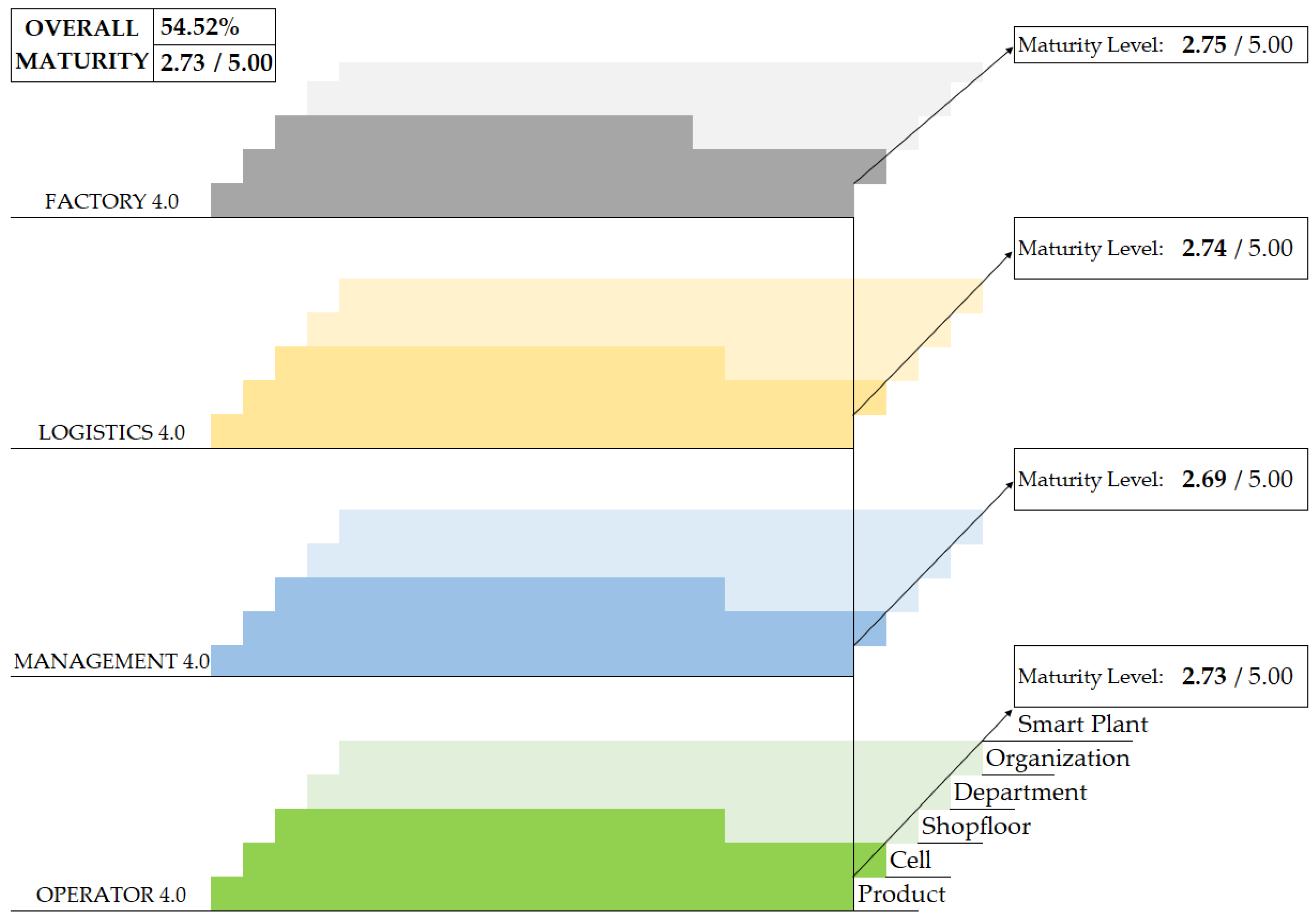
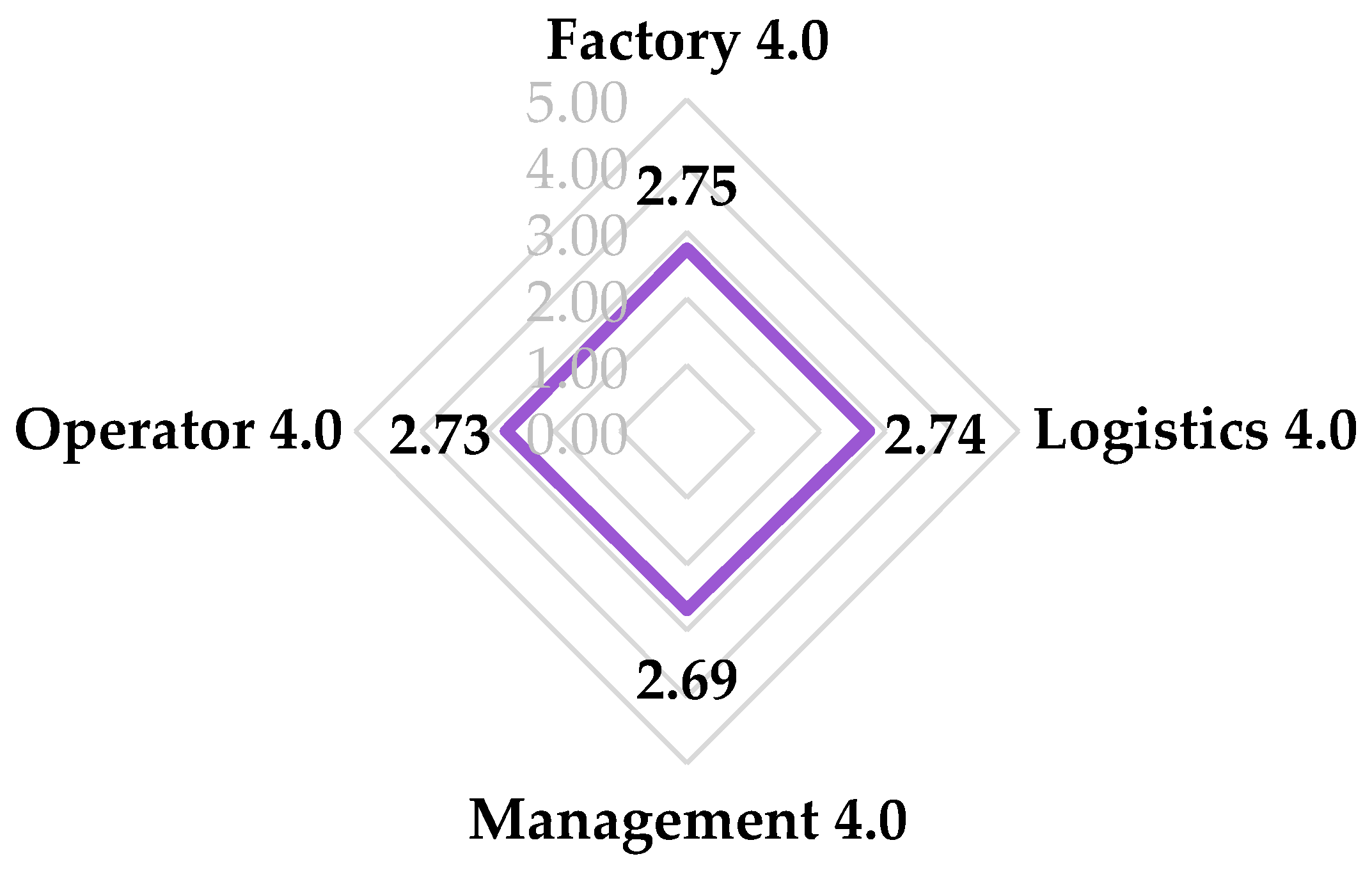

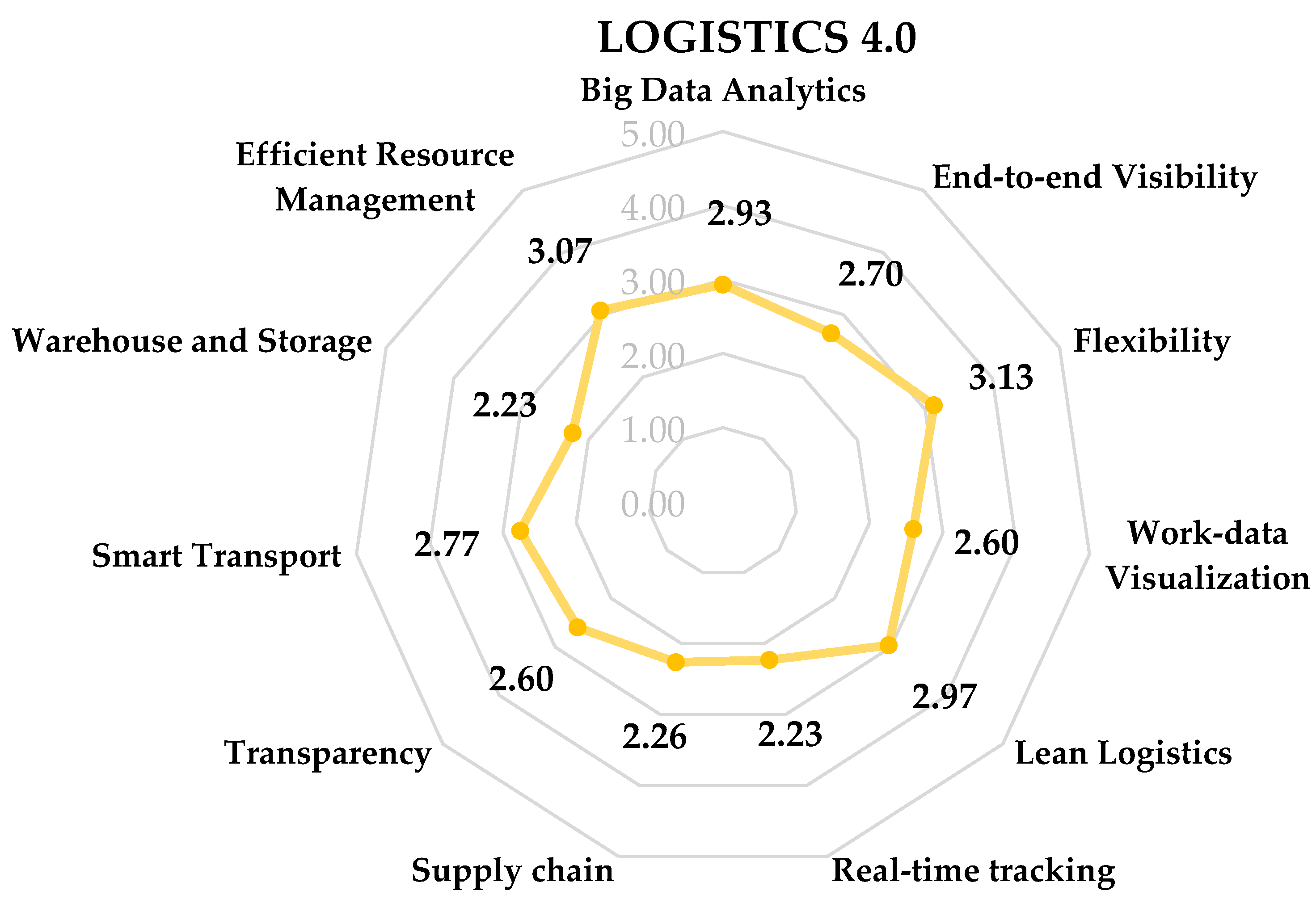

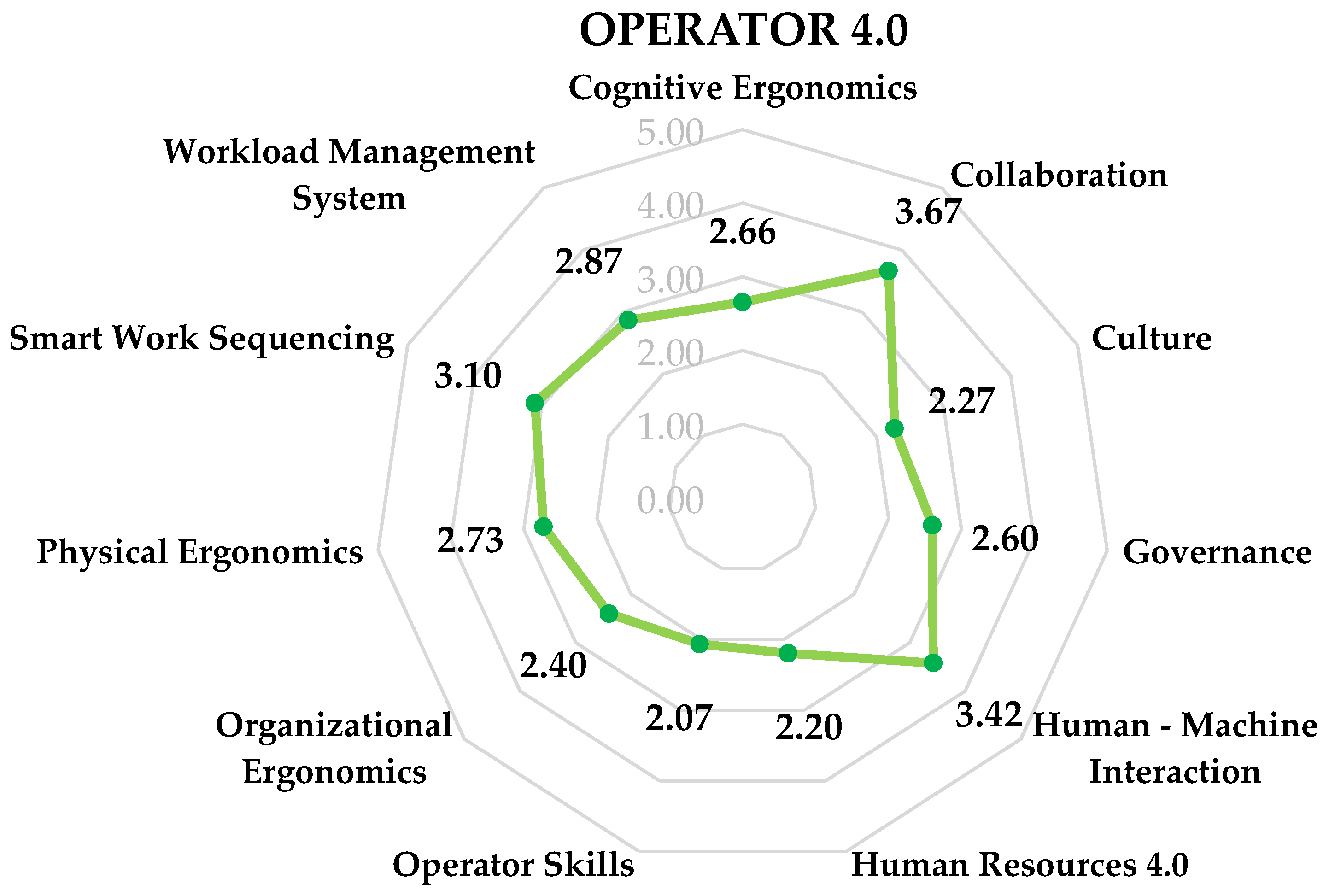
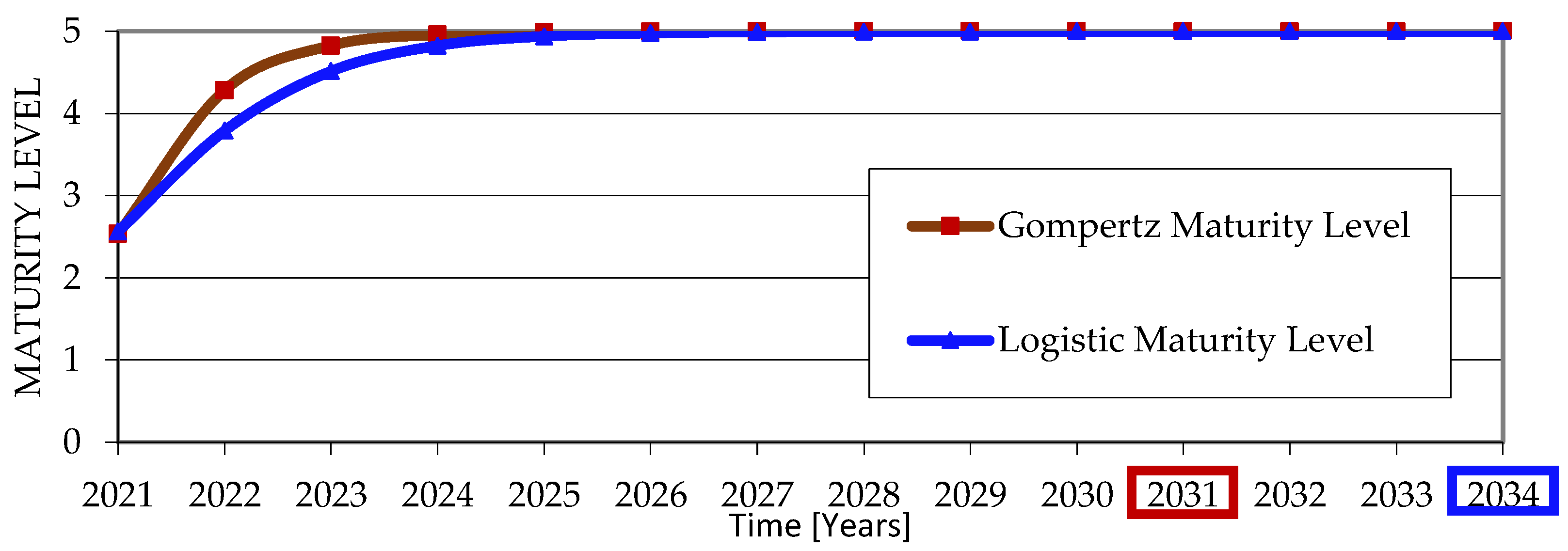

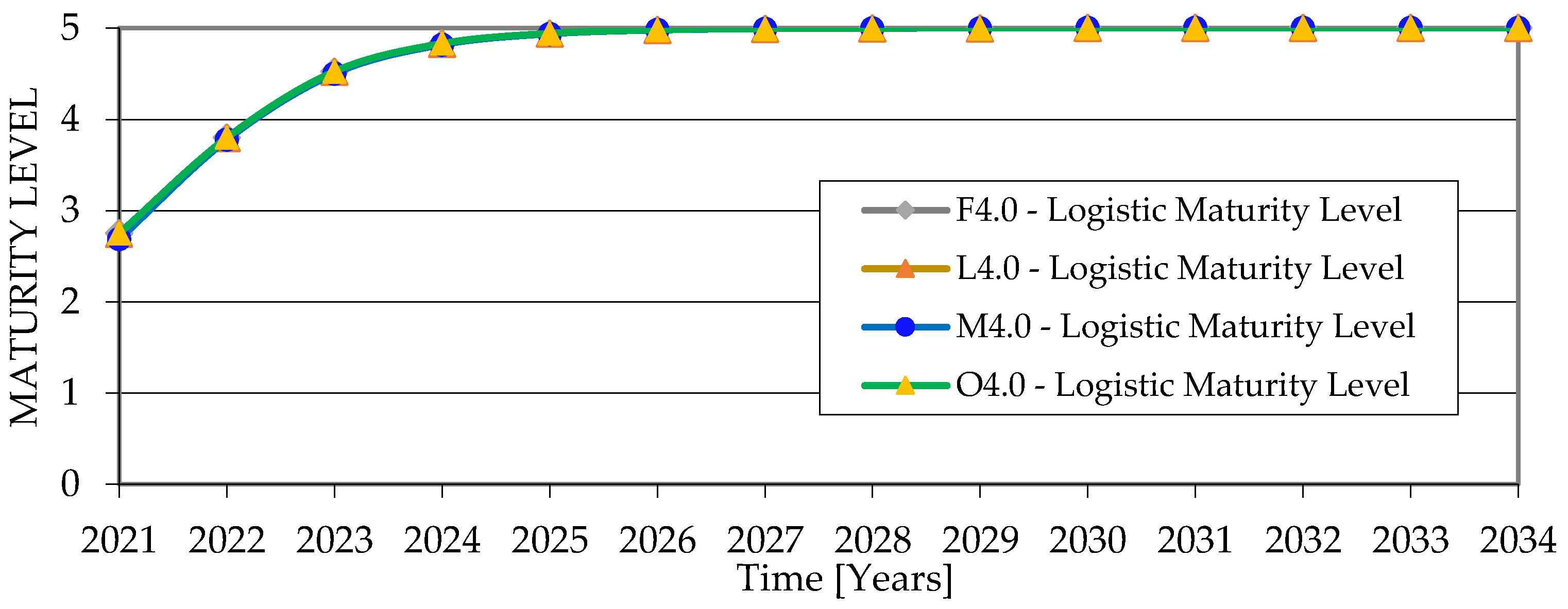
| Maturity Model | Origin | Institution/Source | Assessment Approach | Levels/Dimensions/Items |
|---|---|---|---|---|
| The Connected Enterprise Maturity Model [33] | USA | Rockwell Automation | A five-stage approach to identifying I4.0; technology assessment has four dimensions and five5 levels | Five levels and four dimensions, no details about items |
| IMPULS 1—Industry4.0 Readiness [34] | DE | Manufacturing enterprises | IMPULS MM is developed by a German aircraft manufacturer that specialized in beginner and flight training hang gliders | Six levels, six dimensions, eighteen items |
| RAMI4.0 [35] | DE | Society for measurement, automation, and technology | The Reference Architecture Model Industry (RAMI 4.0) MM has a three-dimensional structure that shows how to approach I4.0 | Six levels, seven dimensions, no details about items |
| Digital Maturity and Transformation [36] | CH | Manufacturing enterprises | Contains nine dimensions: Product innovation, Information Technology (IT), process digitalization, culture and expertise, customer experience, product innovation, strategy, organization, collaboration, transformation management | Nine dimensions, no details about levels and items |
| I4.0 Reifegradmodell [37] | DE | FH—Oberösterreich | Assessment of maturity; no details for items and development of this maturity model is not finished yet | Ten levels, three dimensions, thirteen items |
| Empowerment and Implementation Strategies for I4.0 [38] | DE | Stator assembly for an electrical drive with 30 single teeth and a housing | Assessment of I4.0 MM is used to quickly check and realize a part of a process model | No details about levels, dimensions, or items |
| MM for Industrial Internet [39] | FI | Heavy-equipment manufacturing industries | Provides systematic design guidelines for industrial internet maturity model for mass production manufacturing industries | No details about levels, dimensions, or items |
| A Categorical Framework of Manufacturing for I4.0 [40] | U.K. | Manufacturing enterprises | The five levels contain four dimensions: factory, business, products, and customers | Five levels, four dimensions, no details about items |
| I4.0/Digital Operations Self-Assessment [41] | DE | PricewaterhouseCoopers | Online self-assessment with seven dimensions split into three stages of digital maturity; three of the six maturity dimensions require the use of a consultancy instrument. | Three levels, six dimensions, no details about items |
| SIMMI 4.0 [42] | DE | - | System Integration Maturity Model Industry 4.0 (SIMMI 4.0) has no exploratory case study has been conducted | Five levels, four dimensions, no details about items |
| A Maturity Model for Assessing I4.0 Readiness [14] | DE | Manufacturing enterprises | Readiness and maturity model specifically used to evaluate readiness and maturity of manufacturing enterprises | Five levels, nine dimensions, sixty-two items |
| ACATECH I4.0 Maturity Index [43] | DE | ACATECH, National Academy of Science and Engineering | Value-based development stages presented in the model | Six dimensions, no details about levels or items |
| SPICE-based I4.0 MM [28] | TR | No exploratory case study | Software Process Improvement Capability Determination (SPACE)-based I4.0 MM evaluates system maturity in light of I4.0 | Six levels, nine dimensions, no details about items |
| DREAMY [44] | I | Manufacturing enterprises | Digital Readiness Assessment MM (DREAMY) used to help manufacturing enterprises to create a roadmap for I4.0 integration | Five levels, six dimensions, no details about items |
| The University of Warwick (WMG) MM [45] | U.K. | Crimson & Co., Pinsent Masons | Online self-assessment provided for this model to evaluate maturity of the company | Four levels, six dimensions, fifty-three items |
| Maturity and Readiness Model for I4.0 [29] | TR | Retail company operating in Turkey | Measures companies’ maturity and business levels | Four levels, three dimensions, thirteen items |
| MM for assessing the implementation of I4.0 [46] | IN | Auto-component manufacturing | Implemented to real-world companies to validate the model | Five levels/seven dimensions, thirty-six items |
| Maturity Models | Reference | Fitness of Purpose | Completeness | Dimension Granularity | Measurement Attribute | Complete Method | Objectivity |
|---|---|---|---|---|---|---|---|
| The Connected Enterprise | [33] | N-A | P-A | N-A | N-A | N-A | N-A |
| IMPULS | [34] | P-A | P-A | P-A | L-A | F-A | L-A |
| RAMI 4.0 | [35] | L-A | P-A | L-A | N-A | F-A | L-A |
| Digital Maturity | [36] | P-A | L-A | P-A | P-A | P-A | P-A |
| I4.0 Reifegradmodell | [37] | P-A | P-A | P-A | L-A | F-A | L-A |
| I4.0 Empowerment and Implementation Strategies | [38] | N-A | N-A | N-A | N-A | N-A | N-A |
| MM for Industrial Network | [39] | N-A | N-A | N-A | N-A | N-A | N-A |
| A categorical Framework of Manufacturing for I4.0 | [40] | N-A | N-A | N-A | N-A | N-A | N-A |
| I4.0/Digital operations Self-Assessment | [41] | P-A | P-A | P-A | P-A | N-A | P-A |
| SIMMI 4.0 | [42] | P-A | P-A | P-A | P-A | L-A | P-A |
| An MM for Assessing I4.0 Readiness and Maturity | [14] | P-A | P-A | P-A | P-A | P-A | P-A |
| ACATECH I4.0 Maturity Index | [43] | P-A | P-A | N-A | N-A | N-A | P-A |
| SPICE-based MM | [28] | P-A | L-A | L-A | P-A | F-A | L-A |
| DREAMY MM | [44] | P-A | P-A | P-A | P-A | N-A | P-A |
| WMG MM | [45] | P-A | P-A | L-A | P-A | F-A | L-A |
| Maturity and readiness model for I4.0 | [29] | P-A | N-A | N-A | N-A | N-A | N-A |
| Architecture | I4.0 Technology | Architecture Layers | Architecture Levels | Life-Cycle Value Stream |
|---|---|---|---|---|
| CIMOSA [56] | IT Human–Machine Integration | Organization Resource Information Function | Generic Partial Particular | Requirement Definition Model Design Specification Model Implementation Description Model |
| RAMI 4.0 [35] | Smart Mobility Smart Devices Smart Grid | Business Functional Information Communication Integration Asset | Product Field Device Control Device Station Work Centers Enterprise Connected World | Development Production |
| NIST [57] | Cloud Computing Interoperability Cybersecurity Internet of Things (IoT) | Privacy Security Cloud Services Management Service Orchestration Service Deployment | Application Middleware Operating System | Cloud Carrier Cloud Broker Cloud Provider Cloud Auditor Cloud Consumer |
| The National Institute of Standards and Technology Architecture [59] | Smart Manufacturing Cloud Computing | Cloud Transformation Model Ecosystem Manufacturing System | Product Production Business | - |
| IMSA [58] | Connectivity Cybersecurity | New Business Patterns Information Fusion Interconnection System Integration Resource Elements | Equipment Control Workshop Enterprise Cooperation | Design Manufacture Logistics Sale Service |
| IIRA [47] | Cloud computing Containerization Infrastructure-as-a-Service (IaaS) Platform-as-a-Service (PaaS) | Business Usage Functional Implementation | Manufacturing Transportation Energy Healthcare Retail Smart Factory | Disposal Evaluation Operation Deployment Test/Validation Build Development Prototyping/Design Requirement Conceptualization |
| IBM Industry 4.0 Reference Architecture [60] | Cybersecurity Cloud Computing | Equipment/Device Platform (Hybrid Cloud) Enterprise IT | Data Security Knowledge Devices Service Quality Network Configuration | Edge Plant Enterprise |
| SGAM [54] | Smart Grid | Business Function Information Communication Component | Market Enterprise Operation Station Field Process | Customer Premises Distributed Electrical Resources Distribution Transmission Generation |
| Strengths | Weaknesses | Uses | |
|---|---|---|---|
| Monitoring | Providing large useful information. | Information overload happened without selections. | To provide useful information for structuring a forecast. |
| Expert Opinion | Tapping high-quality models internalized by experts | Identifying experts is difficult and some extraneous factors will affect experts. | To forecast when experts in this field exist and where data are lacking. |
| Trend Analysis | A substantial and data-based forecast of quantifiable parameters. | It requires good and enough effective data and it did not explicitly address the causal mechanisms. | To project quantifiable parameters, and analyze adoption and substitutions of technologies. |
| Modeling | Simplifying the future behavior of complex systems. Building process provides good insight into complex system behavior. | Models that are not heavily data-based may be misleading. | To reduce the complex systems to manageable representations. |
| Scenarios | It can portrait the possible futures explicitly and incorporate qualitative and quantitative information produced by others. | It may be more fantasy than forecast, unless a firm basis in reality is maintained by the forecasters. | To integrate quantitative and qualitative information and to integrate forecasts from various sources. To provide a forecast when data are too weak to use other methods. |
| No | MM Dimension | Description |
|---|---|---|
| 1 | Factory 4.0 | A concept that refers to a modern factory paradigm that has arisen as a result of the fourth industrial revolution. Mechanization, industrialization, and automation are the predecessors of the first three major developmental processes that are known as revolutions. |
| 2 | Logistics 4.0 | Use of digital technologies in the supply chain is referred to as Logistics 4.0. The different facets of end-to-end logistics and supply chain management are discussed by Logistics 4.0. |
| 3 | Operator 4.0 | The primary enabling factor of the resultant Operator 4.0 paradigm focuses on advanced sensors and actuator systems, as well as connectivity solutions. |
| 4 | Management 4.0 | Applies to I4.0 management paradigms such as the ageing population, resource-effective and clean urban manufacturing, mass customization, growing demand heterogeneity, shorter product life cycle, competitive supply chain, unpredictable economies, and cost-containment pressure. |
| 1st-Level Dimensions | 2nd-Level Dimensions | Subdimensions/I4.0 Concept |
|---|---|---|
| Factory 4.0 | Technology integration | Agile manufacturing system |
| Automated manufacturing and assembly | ||
| Continuous and uninterrupted material flow models | ||
| Plug-in produce | ||
| Autonomous workplace | Self-adapting manufacturing systems | |
| Autonomous robotics | ||
| Data-driven services | Integrated and digital real-time monitoring systems | |
| Remote monitoring of products | ||
| Robotics and automation | Smart assistance systems | |
| Digital modeling | Digital twin | |
| Computer-aided manufacturing (CAM) | ||
| Additive manufacturing (3D printing) | ||
| Augmented reality | ||
| Big Data | Big data analytics | |
| Traceability (MES) integration | ||
| Cloud computing | ||
| Machine Learning | Artificial intelligence | |
| IT-supported business | Industrial internet of things (IIoT) | |
| Smart Products | Identification and tracking technology | |
| Customized products | ||
| Digital product-service systems | ||
| Product Design and Development | Product lifecycle management | |
| Communication and Connectivity | Digital and connected workstations | |
| Internet of things | ||
| Cyber–physical systems | ||
| Operations | Self-adapting manufacturing systems | |
| Logistics 4.0 | Transparency | Automated Material Replenishment (E-Kanban) |
| Customers | End-to-end visibility | |
| Inventory control | Wireless communication | |
| Supply chain | Vertical and horizontal system integration | |
| Sustainable supply chain design | ||
| Collaboration network models | ||
| Real-time tracking | Smart sensors | |
| Warehouse and Storage | Automated storage systems | |
| Automated scheduling | Smart assistance systems | |
| Operator 4.0 | Collaboration | Cultural transformation |
| Human resources 4.0 | Training 4.0 | |
| Governance | Operator role | |
| Operator ergonomics | Automated material handling systems | |
| Collaborative robots | ||
| Management 4.0 | Leadership and organization | Decentralization |
| Scheduling and maintenance | Predictive maintenance | |
| Tele-maintenance | ||
| Object self-service | ||
| Investments | Real-time process control systems | |
| Finance | Material requirements planning (MRP) | |
| Manufacturing resource planning | ||
| Servitization and sharing economy | ||
| Data security | Cybersecurity | |
| Intellectual property | Copyrights and patents | |
| Business models 4.0 | Digital lock-in | |
| Freemium | ||
| Standards 4.0 | CPS standards | |
| Innovation strategy | Open innovation | |
| Strategy 4.0 |
| Levels | Experience | Description |
|---|---|---|
| Level 0 | Outsider | Companies have not done anything to deal with I4.0. |
| Level 1 | Beginner | Companies have I4.0-based plans and pilot applications |
| Level 2 | Intermediate | Companies have already taken the first step in I4.0 integration |
| Level 3 | Experienced | Companies use I4.0 technologies in particular areas, but I.40 is not yet extended to the whole company |
| Level 4 | Top Performer | Leading companies that are already well on the way to I4.0 integration |
| Technique and Indicator | Concept | Operational Definition | Gompertz Model | Logistic Model | |
|---|---|---|---|---|---|
| Mean Squared Error (MSE) | Average of the squares of the prediction errors | 0.0372 | 0.0262 | ||
| Root Mean Squared Error RMSE | Standard deviation of the prediction errors | 0.1929 | 0.1619 | ||
| Mean Absolute Error (MAE) | Average of the absolute difference between the prediction errors | 0.1929 | 0.1619 | ||
| Root Mean Squared Logarithmic Error (RMSLE) | Root mean squared log error | 0.0319 | 0.0266 | ||
| Mean Absolute Percentage Error (MAPE) | Mean AbsolutePercentage Error | 7.08% | 5.94% | ||
| Mean Absolute Deviation (MAD) | Mean Absolute Deviation | 0.0708 | 0.0594 | ||
Publisher’s Note: MDPI stays neutral with regard to jurisdictional claims in published maps and institutional affiliations. |
© 2021 by the authors. Licensee MDPI, Basel, Switzerland. This article is an open access article distributed under the terms and conditions of the Creative Commons Attribution (CC BY) license (https://creativecommons.org/licenses/by/4.0/).
Share and Cite
Çınar, Z.M.; Zeeshan, Q.; Korhan, O. A Framework for Industry 4.0 Readiness and Maturity of Smart Manufacturing Enterprises: A Case Study. Sustainability 2021, 13, 6659. https://doi.org/10.3390/su13126659
Çınar ZM, Zeeshan Q, Korhan O. A Framework for Industry 4.0 Readiness and Maturity of Smart Manufacturing Enterprises: A Case Study. Sustainability. 2021; 13(12):6659. https://doi.org/10.3390/su13126659
Chicago/Turabian StyleÇınar, Zeki Murat, Qasim Zeeshan, and Orhan Korhan. 2021. "A Framework for Industry 4.0 Readiness and Maturity of Smart Manufacturing Enterprises: A Case Study" Sustainability 13, no. 12: 6659. https://doi.org/10.3390/su13126659
APA StyleÇınar, Z. M., Zeeshan, Q., & Korhan, O. (2021). A Framework for Industry 4.0 Readiness and Maturity of Smart Manufacturing Enterprises: A Case Study. Sustainability, 13(12), 6659. https://doi.org/10.3390/su13126659







